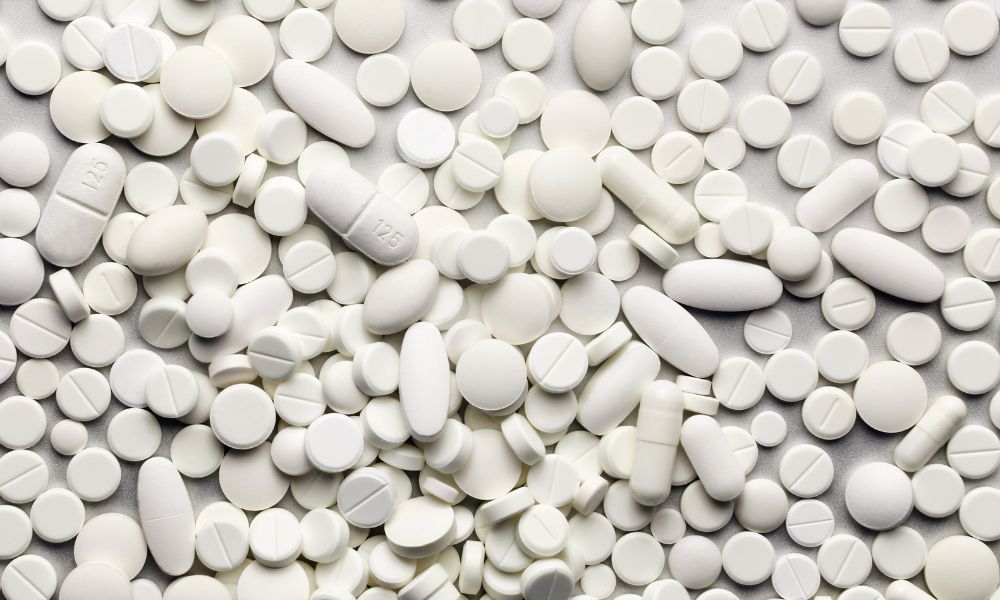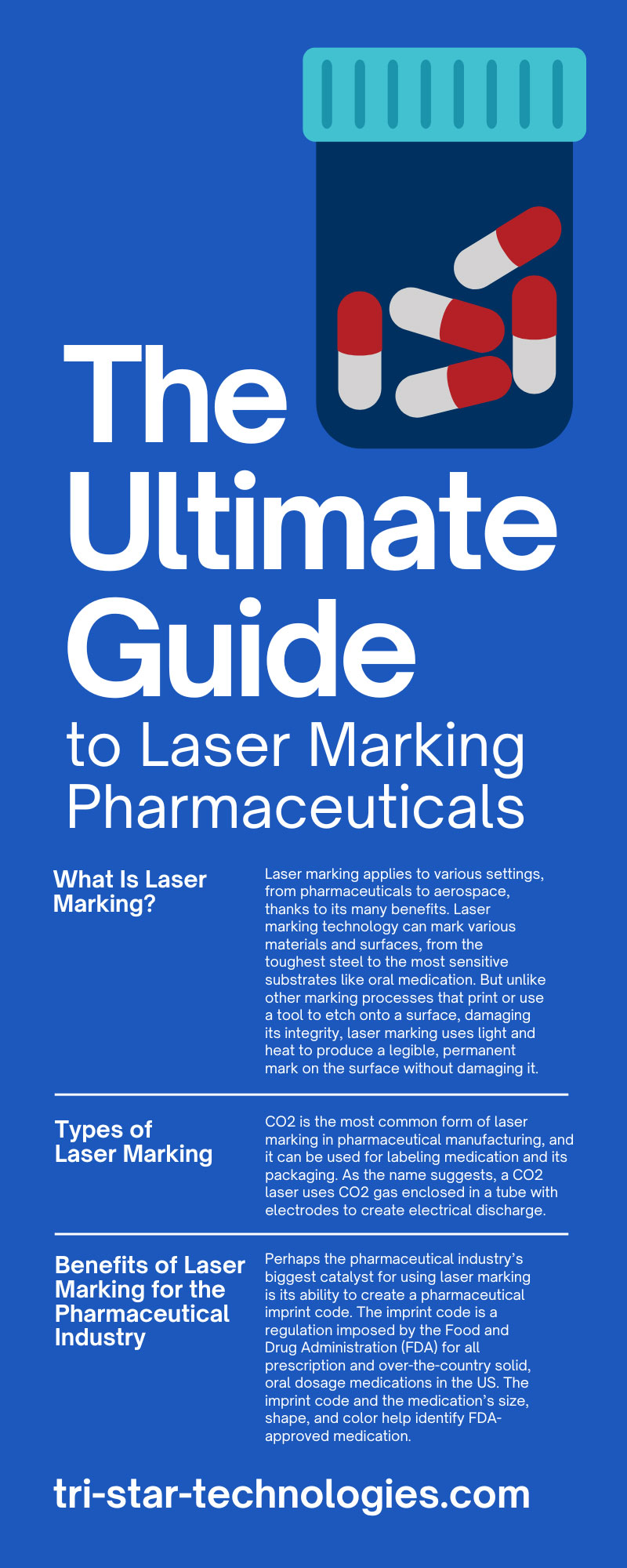The Ultimate Guide to Laser Marking Pharmaceuticals

Laser marking technology is utilized in many industries, but one where it’s prominent is pharmaceutical manufacturing. Learn more about laser marking and pharmaceuticals in our ultimate guide to the industry and how the technology is used.
What Is Laser Marking?
Before we get into how the technology applies to the pharmaceutical industry, we need to explore what laser marking is. Laser marking technology is quickly becoming the preferred industrial labeling and marking method in manufacturing, food processing, and many other industries.
Laser marking applies to various settings, from pharmaceuticals to aerospace, thanks to its many benefits. Laser marking technology can mark various materials and surfaces, from the toughest steel to the most sensitive substrates like oral medication. But unlike other marking processes that print or use a tool to etch onto a surface, damaging its integrity, laser marking uses light and heat to produce a legible, permanent mark on the surface without damaging it.
Types of Laser Marking
There are three main types of laser marking applied in the pharmaceutical industry. While each laser marking method shares the same technological principles, some are more useful in certain applications than others due to their unique properties.
CO2 Laser Marking
CO2 is the most common form of laser marking in pharmaceutical manufacturing, and it can be used for labeling medication and its packaging. As the name suggests, a CO2 laser uses CO2 gas enclosed in a tube with electrodes to create electrical discharge.
This electrical discharge generates plasma within the gas, and the light is amplified as it travels back and forth between the reflective mirror in the enclosed chamber until it reaches the output coupler and comes out as a laser. For marking pills and tables, CO2 laser marking typically uses the laser annealing process, where the laser heats the material surface to create an oxidation process that leaves a permanent mark without damaging the structural integrity of the surface.
UV Laser Marking
Another common method of laser marking is UV laser marking. UV laser marking is ideal for applications requiring color delineation without damaging the surface, like pharmaceutical medication or packaging. UV laser marking is also sometimes referred to as cold marking, as it can mark materials with minimal heat damage due to the high absorption rate of the laser.
The process involves putting the wavelength of a UV laser through a non-linear crystal, which reduces the nanometers (light we perceive) in half before it’s passed through another crystal to reduce its wavelength further. This process creates a cold laser that can still produce high-contrast and legible marks without damaging the surface, making it beneficial for any industry that needs marking on delicate surfaces.
Green Laser Marking
Lastly, there’s green laser marking, another cold laser method typically reserved for marking the most delicate pharmaceutical materials, like softgel tablets. If you’ve ever taken or seen a softgel tablet, you may have noticed a mark or label on the thin, soft surface of the tablet, which is made possible through green laser marking.
Green laser technology operates in much the same way as UV laser marking except in the green visible light spectrum, approximately 532 nanometers.
Benefits of Laser Marking for the Pharmaceutical Industry
We’ve explained the basics of laser marking technology, but why is it so common in pharmaceutical manufacturing? Laser marking technology benefits the pharmaceutical industry in many ways, from marking the most sensitive surfaces to being an eco-conscious method.
The Pharmaceutical Imprint Code
Perhaps the pharmaceutical industry’s biggest catalyst for using laser marking is its ability to create a pharmaceutical imprint code. The imprint code is a regulation imposed by the Food and Drug Administration (FDA) for all prescription and over-the-country solid, oral dosage medications in the US. The imprint code and the medication’s size, shape, and color help identify FDA-approved medication.
With the unique imprint code of the pill or tablet—typically a series of letters, numbers, or symbols—patients, pharmacists, regulators, and law enforcement officials can identify the medication and its active ingredients, dosage strength, and manufacturer through the FDA’s index. But precise marking methods like laser marking are needed to make such delicate imprints on sensitive materials.
Non-Damaging Marks
Another significant benefit of laser marking technology for pharmaceuticals is its ability to make lasting, non-damaging marks on the most delicate surfaces. We all know oral medications like pills and tablets are not the most durable and can crack and disintegrate at the slightest pressure.
Inkjet printing and other methods risk damaging the pills and tablets because they use heat or physically damage the material surface to make an inscription. Laser marking, however, can create even more legible labels without compromising the structural integrity of the medication.
High-Resolution Labeling
Laser marking is also best for creating legible, high-resolution text, symbols, and logos on the smallest surfaces. We all know that ink markings can smear and fade with time, while physical inscriptions on a surface aren’t as visually legible without a color change.
Laser marking sets itself apart by providing a material color change to the surface if needed for a permanent and high-resolution label.
Faster Operations
Pharmaceutical manufacturers also prefer laser marking technology because of its efficient operational speed. Laser marking is fast and simple, requiring few components and minimal operator input.
The laser marking process isn’t impacted by things like ink supply or slowly and delicately carving into the surface—the whole process takes seconds, as lasers are incredibly precise and fast.
Reduced Waste
Laser marking is also the most eco-conscious of all the marking methods available to manufacturers. Unlike inkjet printing and other chemical methods, laser marking produces no environmentally harmful waste and doesn’t require consumables.
Since laser marking is only done with light, there’s no need for ink or chemical consumables, which means a cheaper and more environmentally conscious process for the manufacturers. Less waste also means better efficiency and less time gathering and disposing of consumables.
Where To Get Pharmaceutical Laser Marking Machines
We hope our ultimate guide to laser marking pharmaceuticals has been informative and helpful to those looking to learn more about the technology and the industry. If you think your manufacturing process could benefit from pharmaceutical laser marking equipment, you’ve come to the right place. Browse Tri-Star Technologies and our inventory to learn more about our laser marking machines and how they can help your marking process.



